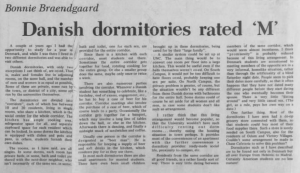
“Danish dormitories rated ‘M'”, Bonnie Braendgaard. The Daily Tar Heel, May 11, 1971. Page 8. Accessed at newspapers.com
UNC’s dormitories faced a crisis in the 1960s: no one wanted to live in them. With the growth of vibrant community social events and the rise of dining on Franklin Street, off-campus housing options became incredibly desirable to upperclassmen. This is in no small part due to the dining halls on campus, which had lapsed in conditions and failed to cater to an increasingly independent student body. Kitchens became a hot point of controversy; students (especially the emerging female student population) wanted the freedom to cook for their friends and provide options that appeased their evolving tastes.
In her 1971 column for the Daily Tar Heel, student Bonnie Braendgaard wrote of UNC dormitories in comparison to the housing she encountered while studying abroad in Denmark. She notes how Danish stay in co-ed corridors that have 10-20 “single rooms” which share a kitchen that “serves as a social center” (1971). This kitchen would be utilized by the entire population of the floor and fostered a camaraderie that she likened to a family. She even presents the idea of a co-op grocery store on campus, “where students could buy most of there food supplies” (1971). For the ultimate convenience of south campus residents, she suggested a placement close to Chase Cafeteria. This, of course, foreshadowed the system widely adopted by UNC in the 21st century, with corridor and suite-style dormitories making up the majority of north and mid campus housing.

“Students become ingenious when learning to cook,” Susan Ross, The Daily Tar Heel, August 25, 1977. Page 23. Accessed at newspapers.com
By 1977, several changes were made in dormitories to encourage and facilitate student cooking at UNC. In an article for the Daily Tar Heel, author Susan Ross interviewed several students on the benefits that on-campus kitchens have on student life. Speaking more to convenience than Braendgaard, the students Ross interviewed cited the location and cost as the biggest reasons to eat in dorms. Students who did not have a kitchen would get resourceful, using irons and hot plates to make their “frozen dinners, soups and hamburgers” (1977). As a side-effect, the article notes that living on-campus became more desirable, and the ratio of student living in Chapel Hill began to level off. This was in no small part to the role food and dining play in campus morale.
On-campus kitchens are an integral part of the Chapel Hill food story as they often shaped the habits and workflow of the students residing there. The options available greatly affected where students worked and who they lived with, as responsibilities were often shared between housemates. As you can view in these articles and across this website, food was considered a form of equality and unity, and the act of dining brought people together fostered a common awareness among the issues at hand in a population. On-campus kitchens were no exception.